China’s Deflation Fears Are Rising; Gov’t Seeks to Boost Consumption

NPPC details cost of complying with Calif. Prop 12 requirements
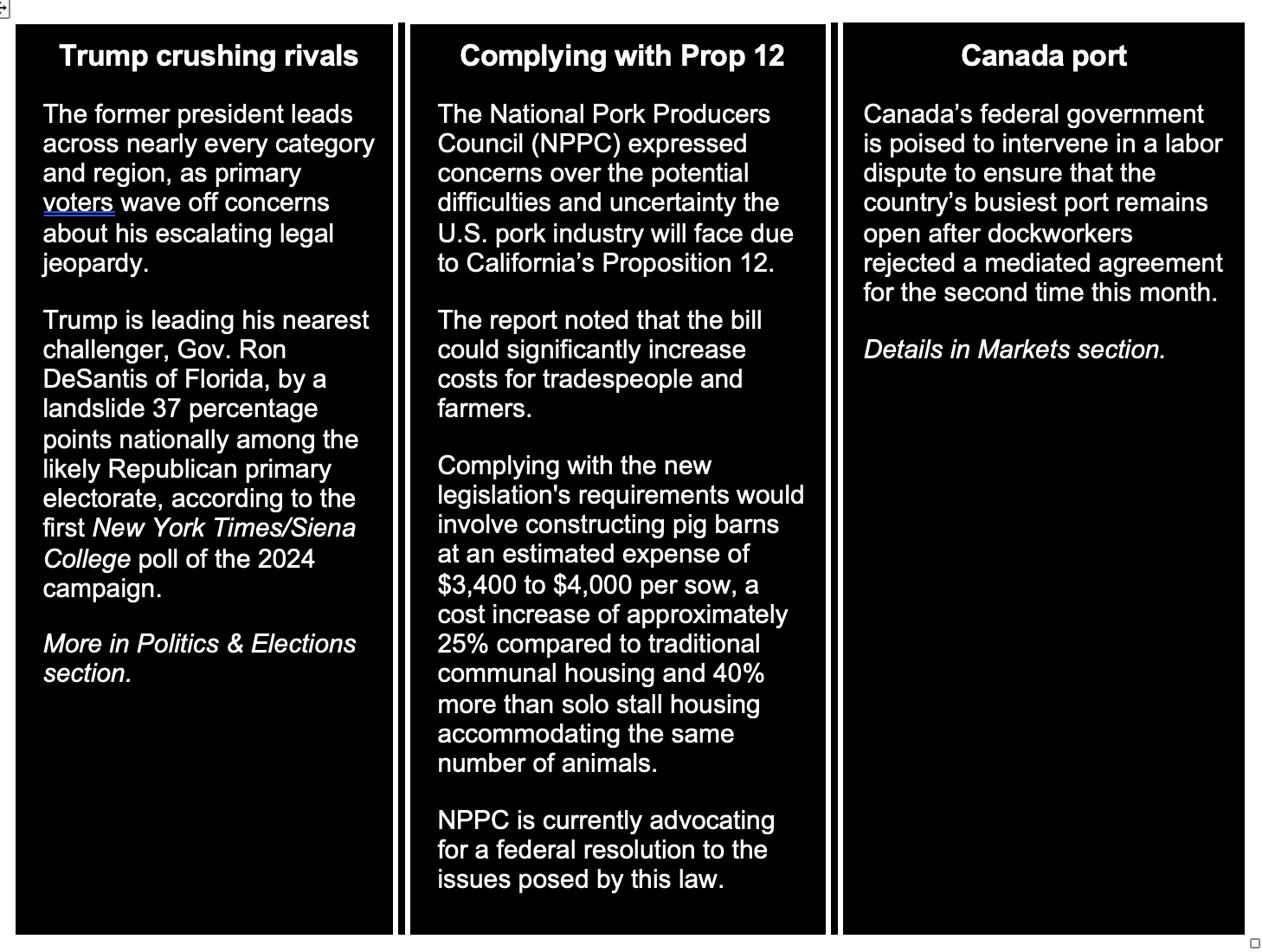
|
In Today’s Digital Newspaper |
USDA daily export sales:
• 132,000 metric tons soybeans to China during 2023-2024 marketing year
• 183,300 metric tons soybean cake and meal to the Philippines during 2023-2024 MY
China is seeking to boost consumption to spur the faltering economy. Meanwhile, economists fear China may be heading for deflation, even as the rest of the world worries about inflation. The Chinese economy grew just 0.8% in the second quarter, compared with the previous three months, hurt by weak consumer spending, high youth unemployment and a downturn in real estate. More in China section.
The Eurozone economy resumed growth while core inflation didn’t slow. Meanwhile, Germany’s economy — Europe’s largest — is struggling to grow, and the weakness is set to persist.
Yellow, the trucking behemoth formerly known as YRC Worldwide, is closing its operations and filing for bankruptcy protection. Details in Markets section.
U.S. home insurance industry is coming under scrutiny as insurers impose significant changes in their financial practices to return to profitability after suffering losses in five out of the past six years.
Indian basmati rice exporters have been receiving early order requests amid concerns that India could apply a ban on basmati rice exports, like what was done earlier this month with non-basmati white rice exports, according to Reuters.
Ag sector focusing on congressional amendments. Over the next few months, you will hear about farm policy proposals that farm-state lawmakers and others are proposing for the fiscal year (FY) 2024 Ag appropriations bill or the new farm bill. See Policy section for a list of some of the amendments being monitored.
EPA has scheduled an additional meeting, making for a total of nine meetings at the Office of Management and Budget (OMB), to discuss its planned alterations to the Waters of the U.S. (WOTUS) rule.
The Biden administration is launching a beta version of a website for a new income-driven student loan repayment plan called SAVE (Saving on a Valuable Education), officials told CNN.
The Canadian government is prepared to step in to resolve a labor dispute that threatens operations at the nation's busiest ports. Details in Markets section.
Ukrainian President Volodymyr Zelenskyy announced that the war was "returning to Russia's territory.” Meanwhile, Russia said it will continue dialogue on peaceful resolution of Ukraine crisis with China, Brazil and Africa. More info on both in Russia & Ukraine section.
Seeking to cut greenhouse gas emissions, the Biden administration issued a proposal directing automakers to raise the fuel economy of their vehicles to a fleet-wide average of 58 miles per gallon by 2032. The proposed rules by the National Highway Traffic Safety Administration would be applicable starting in model year 2027, while new fuel efficiency standards for heavy-duty pickup trucks and vans would rise 10% annually. The NHTSA also said it would try to align regulations with the Environmental Protection Agency's proposed vehicle emissions reductions. More in Energy section.
The Centers for Disease Control and Prevention (CDC) said the recent surge in Covid-19 cases in the U.S. might be signaling a smaller summer Covid-19 wave.
Johnson & Johnson's second attempt to reduce legal responsibilities associated with talc-related lawsuits has been thwarted by a federal judge.
|
MARKET FOCUS |
Equities today: Asian and European stock markets were mixed to higher in overnight trading. U.S. Dow opened slightly lower and then rose slightly higher. In Asia, Japan +1.3%. Hong Kong +0.7%. China +0.5%. India +0.6%. In Europe, at midday, London flat. Paris +0.7%. Frankfurt +0.2%.
U.S. equities Friday: All three major indices registered gains Friday which resulted in weekly gains of 0.7% for the Dow, over 2% for the Nasdaq and 1% for the S&P 500. On Friday, the Dow moved up 176.57 points, 0.50%, at 35,549.29. The Nasdaq gained 266.55 points, 1.90%, at 14,316.66. The S&P 500 was up 44.82 points, 0.99%, at 4,582.23.
Yellow, the trucking behemoth formerly known as YRC Worldwide, is closing its operations and filing for bankruptcy protection due to an unsuccessful attempt to restructure its debt exceeding $1 billion. Their considerable debt includes a $700 million pandemic relief loan from the Trump administration, an agreement that provided the U.S. Treasury with a 30% stake in the business. That loan and other debt payments totaling $1.3 billion were due this fall. During the threatened strike, the company warned it was cash-poor and the situation prompted companies to shift their transportation needs away from Yellow, causing an 80% decline in their business. This financial turmoil has driven the company's shares down to less than $1 each. Yellow, once serving prominent clients such as Walmart and Home Depot, employs a workforce of 22,000 people who are members of the Teamsters union.
Impact: The WSJ reports that Yellow’s demise marks trucking’s biggest-ever collapse, surpassing the abrupt Consolidated Freightways shutdown in 2002 in terms of revenue and jobs. Customers are likely to see only limited disruptions in supply chains, however, since shippers have already been shifting their cargoes to other carriers at a rapid rate.
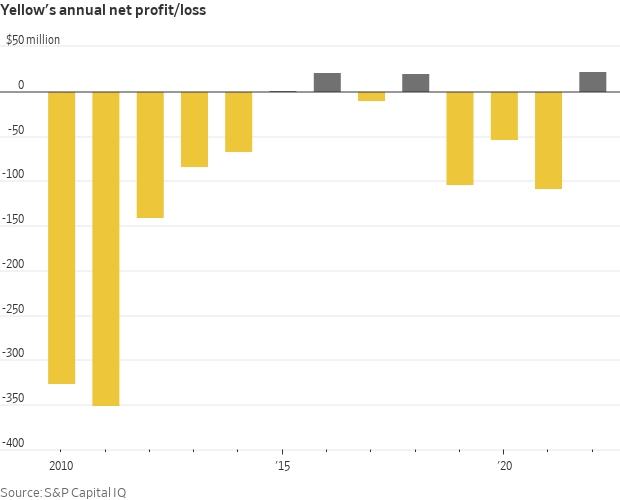
Chevron and Exxon reported their weakest quarterly profits in more than a year, as financial gains at the two largest American oil companies moderate after spiking to record levels in the immediate aftermath of Russia’s invasion of Ukraine.
Agriculture markets Friday:
- Corn: December corn futures fell 12 1/4 cents, before settling at $5.21, ultimately falling 15 1/4 cents on the week.
- Soy complex: November soybeans fell 15 1/2 cents to $13.82 1/2 and finished 19 1/4 cents lower on the week. August meal fell $9.30 to $455.20. August soyoil fell 101 points to 67.60 cents.
- Wheat: December SRW wheat futures fell 7 1/2 cents to $7.28, near mid-range and for the week up 10 1/4 cents. December HRW wheat futures lost 8 3/4 cents to $8.69 1/4, near mid-range and on the week up 2 1/2 cents. September spring wheat futures fell 8 1/4 cents on the session to $8.96, though still gained 9 cents on the week.
- Cotton: December cotton futures fell 12 points to 84.26 cents and for the week fell 22 points.
- Cattle: Live cattle futures ended Friday narrowly mixed, with nearby August edging up 10 cents to $178.15; that represented a weekly decline of $1.875. Feeder futures rallied in response to fresh grain/soy weakness. August feeders rose 95 cents on the day to $245.60, thereby marking a weekly dip of 42.5 cents.
- Hogs: August lean hog futures rose $1.175 to $103.20, near the daily high and hit a 4.5-month high. For the week, August hogs gained $2.535.
Ag markets today: Corn, soybeans and wheat faced heavy price pressure during the overnight session. As of 7:30 a.m. ET, corn futures were trading 12 to 14 cents lower, soybeans were 22 to 27 cents lower, SRW wheat was 19 to 24 cents lower, HRW and HRS wheat were 14 to 16 cents lower. Front-month crude oil futures were around 75 cents higher, and the U.S. dollar index was modestly firmer.
Market quotes of note:
- Fed watch. According to Dr. Vince Malanga, president of LaSalle Economics: “The [Fed] Chair’s next policy address will occur at the annual Jackson Hole, Wyo., seminar at which he will have another set of labor and inflation reports to ponder. The FOMC next meets in late September following yet another set of inflation and labor reports. So, there is now a lengthy interval for assessing progress toward the 2% price stability goal. This interval will end just as Congressional haggling over the federal appropriations process intensifies. FOMC discussions will not be acrimonious but Congressional haggling most assuredly will be.”
- China: “We’ve noticed that the growth momentum of some consumption categories is still not solid yet, and some residents have relatively weak confidence to spend,” China’s NDRC Vice Chairman Li Chunlin told reporters. “This requires further policy support.”
- Goldman Sachs economists are saying to keep an eye on electricity prices. Those paid by consumers are starting to unwind what’s been a 25% surge since 2019, they said late last week. Using a consumer price index measure, Goldman’s team is projecting a 3% to 4% pullback in cumulative electricity prices by this fall, economist Spencer Hill wrote in a note. Goldman even shaved its December CPI year-on-year inflation forecast to 2.9% from 3.1% as a result. “We estimate that the tailwind from cheaper electricity could offset as much as half of the consumption drag from the resumption of student loan payments,” Hill wrote.
- “Yellow couldn’t manage itself, and it wasn’t up to Teamsters to do it for them.” — A Teamsters spokesman.
On tap today:
• Economic reports. Chicago PMI | Dallas Fed Mfg. Survey
• Energy reports. Brent September futures expire | Earnings: Galp; Saras.
• USDA reports. AMS. Export Inspections NASS: Crop Progress
The Eurozone saw its annual inflation rate decelerate for the third straight month to a total of 5.3% in July, down from 5.5% in June, which aligns with market predictions. This marks the lowest annual inflation rate since January 2022. The reduction was attributed to a subsequent fall in energy prices, even as the prices of services continued to rise. Contrarily, the core inflation rate, which disregards volatile items such as food and energy, remained steady at 5.5%, slightly above the forecasted 5.4%.
The Eurozone economy experienced a 0.3% growth in Q2 2023, slightly better than the anticipated 0.2% expansion. This growth comes after a flat first quarter, with the upward trend likely driven by a moderation in inflation. Nevertheless, challenges persist, as higher interest rates and decreasing confidence continue to put pressure on the Eurozone's economy.
In terms of individual economies within the Eurozone, France and Spain reported consistent growth, while Germany's economic activity remained stagnant. Contrary to expectations, Italy faced an economic contraction. Comparing on an annual basis, the Eurozone saw a growth of 0.6%, which marked the slowest rate of expansion since the recession period of 2020-21.
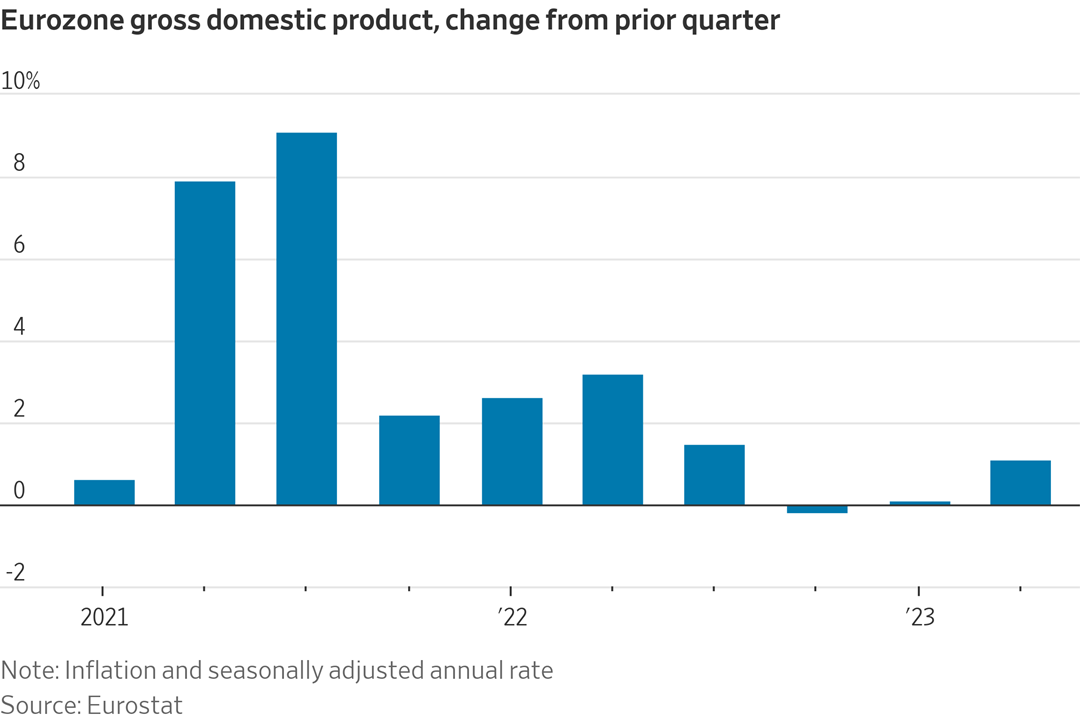
The U.S. home insurance industry is coming under scrutiny as insurers impose significant changes in their financial practices in an attempt to return to profitability after suffering losses in five out of the past six years, the Wall Street Journal reports (link). Evidently, this struggle to regain solvency has led to several dramatic changes including, but not limited to, double-digit premium increases and excessively high deductibles. Furthermore, companies are cracking down on claims, enacting new coverage restrictions, and utilizing drones for detailed inspections of insured properties; the latter is a means to ensure that insurance claims are valid, mitigating losses for the companies. In essence, while insurers are finding new ways to adjust, customers are increasingly shouldering a greater financial burden and receiving less coverage in return.
H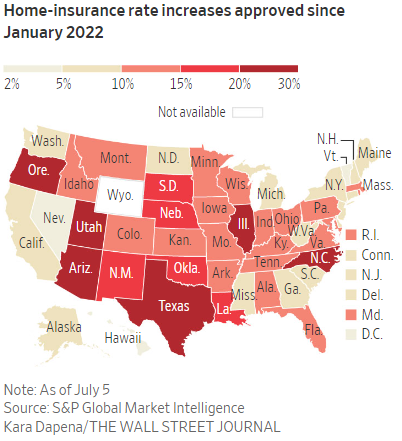
For a first-time homebuyer to afford a typical starter home in the U.S., they must earn about $64,500 — an increase of 13% from a year ago, largely because of higher mortgage rates, fewer listings and higher home prices, according to a new study from Redfin (link). The median starter home price in June was $242,000—a 2.1% increase from last year and up more than 45% since the pandemic.
Market perspectives:
• Outside markets: The U.S. dollar index was slightly higher. The yield on the 10-year U.S. Treasury note was higher, trading around 3.96%, with a mixed tone in global government bond yields. Crude oil futures advanced, with U.S. crude around $81.30 per barrel and Brent around $85 per barrel. Gold and silver were narrowly mixed, with gold weaker around $1,996 per troy ounce and silver higher around $24.50 per troy ounce.
• Indian basmati rice exporters have been receiving early order requests amid concerns that India could apply a ban on basmati rice exports, like what was done earlier this month with non-basmati white rice exports, according to Reuters. This fear has arisen due to a 3% increase in prices over a month and damage to the crop due to late monsoon rains. Under ordinary circumstances, buyers sign contracts for monthly shipments, however, due to the current circumstances, some are requesting that shipments, initially scheduled for September and October, be delivered in August instead. Though India has never stopped basmati rice exports in the past, it did impose export taxes on the product back in 2008. (The Indian government banned the overseas sale of non-basmati white rice to slash prices in its domestic market.)
Meanwhile, India’s move has led to shortages, price spikes and scenes of panic buying across North America, from Ontario to Dallas. Indian grocery stores in the Seattle area have also described runs on rice, according to The Seattle Times (link).
• The Canadian government is prepared to step in to resolve a labor dispute that threatens operations at the nation's busiest ports. This follows the dockworkers' rejection of a mediated agreement for the second time in July. The disagreement involves more than 7,000 dockworkers who went on strike on July 1 for 13 days, significantly disrupting trade through the ports of Vancouver — which is the busiest maritime hub in Canada — and Prince Rupert in British Columbia. This had major economic repercussions, stalling an estimated CAD $10 billion ($7.6 billion) worth of shipments, causing pulp mills to shut down, mines to curtail their operations, and led to an increase in the cost of goods for numerous businesses. (Link to Bloomberg for details).
Labor Minister Seamus O’Regan Jr. asked the Canada Industrial Relations Board to analyze whether the dockworkers union's rejection of the deal eliminates the possibility of a peaceful, negotiated resolution. Depending on the board's findings, the government has the authority to either set a new collective agreement for the disputing parties, or declare final binding arbitration. O’Regan stated that the Canadian government is prepared for all possible outcomes. This intervention aims at preventing further economic disruption caused by the ongoing dispute. The seriousness of the situation had led to Prime Minister Justin Trudeau's administration bringing in a mediator earlier in the hope of negotiating a deal between the parties.
• Ag trade: South Korea purchased 65,000 MT of corn expected to be sourced from Brazil. Algeria tendered to buy a nominal 50,000 MT of optional origin soft milling wheat.
• NWS weather outlook: There is a Slight Risk of excessive rainfall over parts of the Central High Plains... ...Excessive Heat Warnings and Advisories from parts of Central/Southern Plains and the Lower Mississippi Valley/Central Gulf Coast.

Items in Pro Farmer's First Thing Today include:
• Grains sharply lower to open the week
• Some weather stress, some improved conditions
• Pope urges Russia to restore Black Sea grain deal
• Cattle traders remain cautious
• Cash hog index slips
|
RUSSIA/UKRAINE |
— Ukrainian President Volodymyr Zelenskyy announced that the war was "returning to Russia's territory," stirring tensions in the ongoing conflict. This statement came as Russian officials reported that Ukrainian drones had launched an attack on Moscow, although the damage was minimal with no recorded injuries. Zelenskyy further highlighted that the warfare in Russia was a part of what he described as an "inevitable natural and fair process.” Ukraine's much-anticipated counteroffensive is underway, though its commencement seems to be slower than originally anticipated.
Meanwhile, former President Dmitry Medvedev said Moscow would be forced to use a nuclear weapon if Kyiv's counteroffensive turned out to be successful.
— Russia will continue dialogue on peaceful resolution of Ukraine crisis with China, Brazil and Africa. Russia’s Foreign Ministry said Moscow would continue dialogue on prospects for a peaceful resolution of the Ukraine crisis with China, Brazil and African partners, Russian state-owned news agency RIA reported. The statement followed a Russia/African summit last week at which some African leaders pressed Russian President Vladimir Putin to end the war in Ukraine.
|
POLICY UPDATE |
— Student loans. The Biden administration is launching a beta version of a website for a new income-driven student loan repayment plan called SAVE (Saving on a Valuable Education), officials told CNN. This comes as federal student loan payments are about to resume in October. The SAVE plan was established after the Supreme Court invalidated President Biden's initiative to forgive student loan debt in June. Under the new scheme, borrowers' payments will be calculated according to their income and family size. The Department of Education estimates that this could potentially reduce repayments for around 1 million borrowers to as little as $0. The beta website (link) is now accessible for borrowers to start their enrollment process, which is estimated to take roughly 10 minutes.
— WOTUS update. The Environmental Protection Agency (EPA) has scheduled an additional meeting, making for a total of nine meetings at the Office of Management and Budget (OMB), to discuss its planned alterations to the Waters of the U.S. (WOTUS) rule. This rule, finalized earlier this year, has to be modified in response to a decision from the U.S. Supreme Court. The most recent meeting scheduled is with the Environmental Protection Network, an organization comprised of 550 former EPA staff and officials nationwide. This meeting is slated for Aug. 9.
— Ag sector focusing on congressional amendments. Over the next few months, you will hear about farm policy proposals that farm-state lawmakers and others are proposing for the fiscal year (FY) 2024 Ag appropriations bill or the new farm bill.
Several positive amendments have been filed, including an amendment to prohibit funding for regulating or requiring farmers to disclose scope 3 emissions under the “The Enhancement and Standardization of Climate-Related Disclosures for Investors,” an amendment to increase funding for the National Animal Health Laboratory Network, an amendment to increase payments under the Livestock Indemnity Program, and an amendment to ensure that all types of milk are available to school children, amongst others.
But several amendments have drawn intense criticism. One would prohibit funding of commodity checkoff programs... but it is not garnering much support. Three separate amendments are aimed at gutting U.S. sugar policy and offshoring U.S. production and processing. Amendments aimed at eliminating or significantly reducing funding for U.S. food aid programs were also filed. Another would lower pay limits and further restrict farm labor requirements that diminish active personal management.
|
CHINA UPDATE |
— In July 2023, China’s NBS Manufacturing Purchasing Managers Index (PMI) increased to 49.3, up from 49 in June and outpacing market predictions of 49.2. Despite the rise, this figure marks the fourth consecutive month of shrinking industrial production, hinting at a weakening post-pandemic recovery momentum. Details of the report revealed that both new orders and export sales declined for the fourth month successively, recording 49.5 and 46.3 respectively over June's figures of 48.6 and 46.4. Further, purchasing activity experienced a less severe drop, reaching 49.5 from June's 48.9.
Employment continued its downward trend for the fifth consecutive month, with a sharper decline depicted at 48.1 from June's 48.2. On a positive note, production rose for the second month in a row with a figure of 50.2 against 50.3 in June. Delivery time remained mostly the same, with a marginal increase to 50.5 from 50.4.
Regarding prices, the cost of inputs increased for the first time since March, and did so at the quickest rate in the past five months (52.4 up from 45.0). Conversely, output prices fell for the fifth consecutive month, although the reduction was the smallest in the last four months, with the figure standing at 48.6 compared to 43.9 in June.
Lastly, business sentiment showed signs of resilience and improvement, reaching a four-month high at 55.1 versus June's 53.4. Overall, the manufacturing industry reveals mixed signals with mild signs of recovery, but still showing some areas of continuous decline.

— China’s government is looking to enhance its economic recovery by increasing consumption but is avoiding the direct fiscal support to consumers and businesses for boosting spending. To this end, the National Development and Reform Commission, the country's main economic planning agency, has published an extensive policy document.
The policy features plans to lift various government-imposed restrictions which curb consumption, for instance, limits on car purchases. Further, the document aims at developing infrastructure and organizing promotional events, such as food festivals, which can indirectly incentivize consumer spending. The methods proposed seem to be oriented toward stimulating consumption but without resorting to direct economic stimulus packages.
— Deepening worries about deflation in China are evident, a situation that could impose additional tension on Beijing to stimulate economic growth and avoid a long-term economic pitfall, the Wall Street Journal reports (link). In case a sustained period of price reduction occurs, it might affect corporate revenues negatively, dampen consumer expenditure, and lead to higher unemployment. This situation could have worldwide implications. On one side, it could lead to lower prices for certain goods imported from China to countries such as the U.S., thereby benefiting consumers in those countries. However, a downside would be a negative impact on the worldwide demand for raw materials and consumer goods, since China is a significant global purchaser.
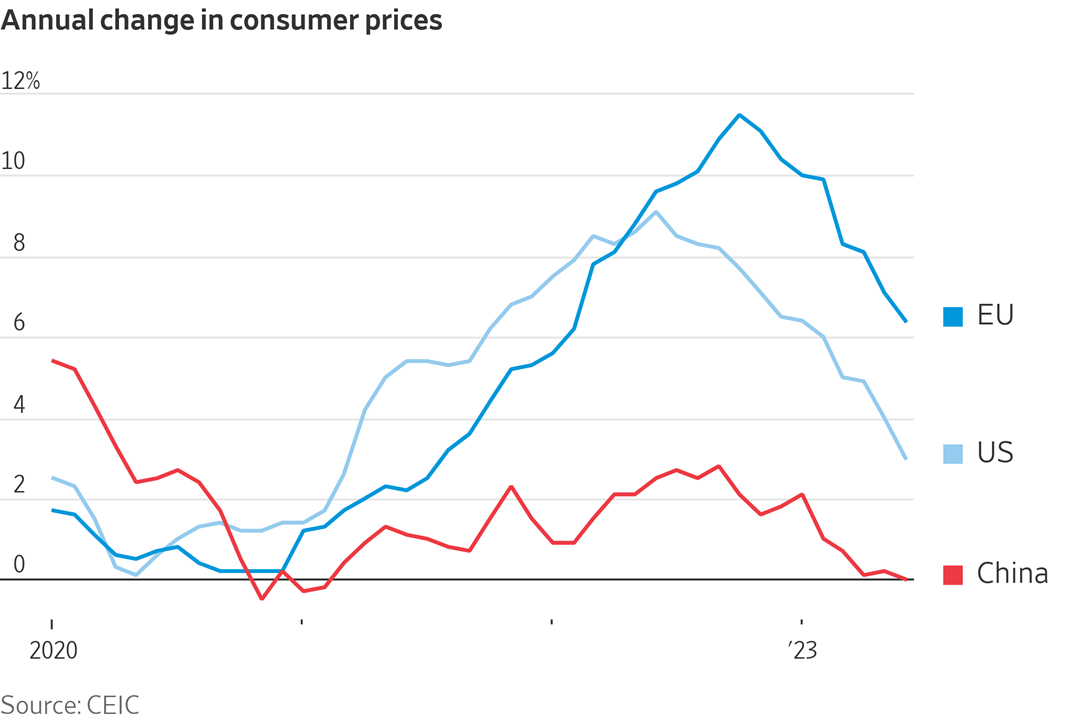
— China curbs drone exports after U.S. says it aids Russia war effort. China slapped restrictions on the export of drones and certain components used in their manufacture, a move that could hurt production abroad of the aerial vehicles including types employed by armed forces in the Ukraine war.
|
TRADE POLICY |
— China, Russia and Norway are the countries in the world which export much more than they import (in monetary terms) as the list was reshuffled following the Ukraine war energy crisis. Exporters of now very expensive fossil fuels saw shifts in their trade balances towards more profitable exports. China leads the list, relegating major exporters Germany and Japan to lower ranks.

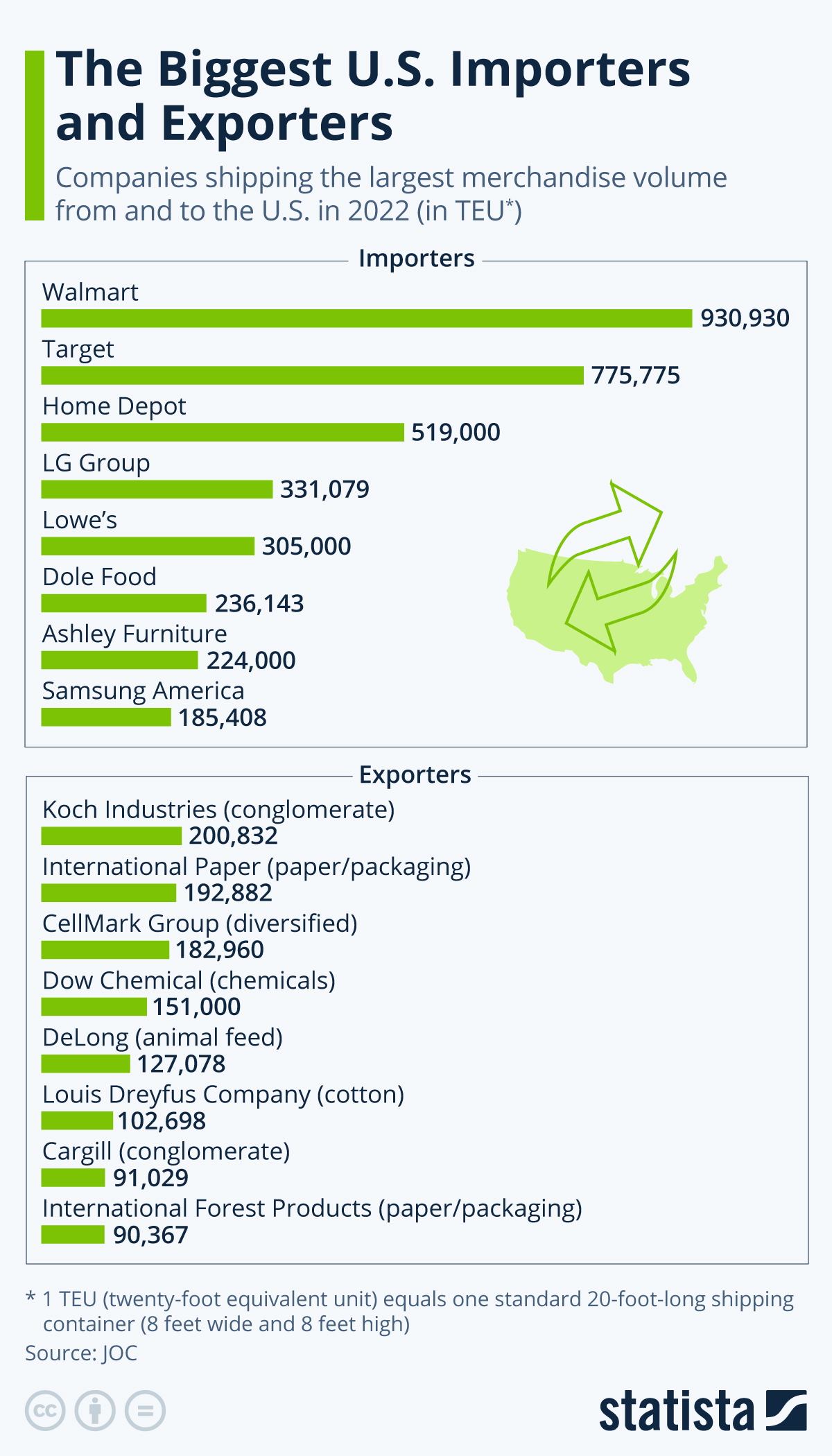
|
ENERGY & CLIMATE CHANGE |
— The National Highway Traffic Safety Administration (NHTSA) proposed stricter fuel-economy standards for light-duty vehicles. The proposed standards would increase the required average fuel efficiency for new cars and trucks from 49 miles per gallon (mpg) in 2026 to 58 mpg by 2032. Proponents note this would help consumers save money at the pump and lead to decreased pollution.
Although the proposal does not directly mandate automakers to produce electric vehicles (EVs), it's believed that enforcing these rules would heavily incentivize the industry to significantly upsurge EV sales to comply. Currently, EVs only account for about 7% of U.S. vehicle sales.
NHTSA will collect public comments for 60 days about the proposed rules before finalizing them.
|
HEALTH UPDATE |
— The Centers for Disease Control and Prevention (CDC) said the recent surge in Covid-19 cases in the U.S. might be signaling a smaller summer Covid-19 wave. Key indicators like hospital admissions, test positivity rates, and emergency department visits for the virus have subtly risen since mid-July, but the numbers are still relatively low on a national scale. CDC spokesperson Kathleen Conley stated that although the current Covid-19 rates are close to a historic low following seven months of consistent decline, the recent increase is not unexpected, as the U.S. has witnessed similar patterns in the past three summers.
Experts maintain that current data doesn't necessarily confirm a larger outbreak on the horizon. However, the situation requires continuous observation. Over 144 million Covid-19 vaccine doses have been administered in the U.S., with approximately 56.4 million people having received their booster shots.
— Johnson & Johnson's second attempt to reduce legal responsibilities associated with talc-related lawsuits has been thwarted by a federal judge. The company had hoped to leverage the bankruptcy filing of its subsidiary to handle lawsuits which allege that its talcum powder products are cancer-causing. Due to this decision, a proposed settlement worth $8.9 billion, intended to resolve most of the litigation, is now at risk. The company, however, has responded saying it intends to challenge the decision through an appeal.
|
POLITICS & ELECTIONS |
— Trump is crushing DeSantis and other GOP rivals: Times/Siena poll finds. According to the first Times/Siena College poll for the 2024 campaign, Donald Trump is currently leading the race for the Republican nomination. The poll shows Governor Ron DeSantis trailing by a staggering 37 percentage points, suggesting that even if all other Trump opponents were to drop out, he would still fall short. Despite facing indictments, Trump's vast and loyal supporter base poses a significant challenge for other candidates, according to analyst Nate Cohn.
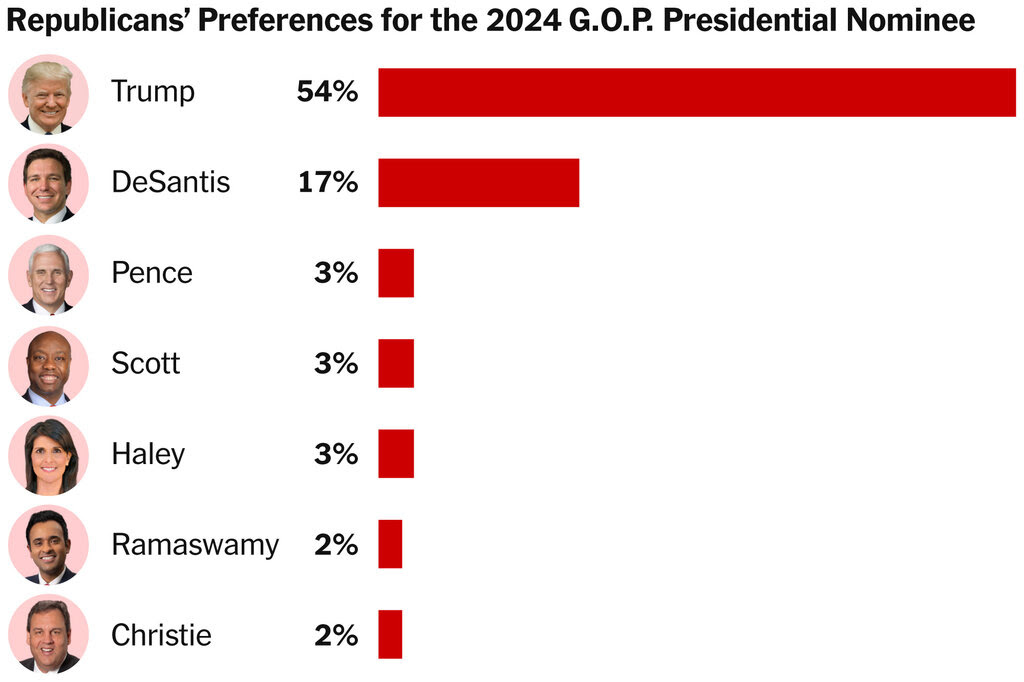
— 40% is President Biden’s approval rate in a new CBS News-YouGov poll that also found his approval rating on the economy at just 34%.
|
KEY LINKS |
WASDE | Crop Production | USDA weekly reports | Crop Progress | Food prices | Farm income | Export Sales weekly | ERP dashboard | California phase-out of gas-powered vehicles | RFS | IRA: Biofuels | IRA: Ag | Student loan forgiveness | Russia/Ukraine war, lessons learned | Russia/Ukraine war timeline | Election predictions: Split-ticket | Congress to-do list | SCOTUS on WOTUS | SCOTUS on Prop 12 pork | New farm bill primer | China outlook | Omnibus spending package | Gov’t payments to farmers by program | Farmer working capital | USDA ag outlook forum | Debt-limit/budget package |






